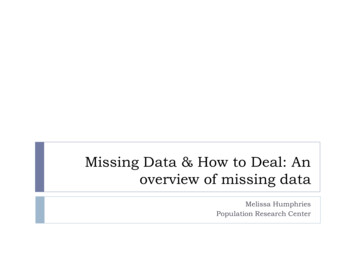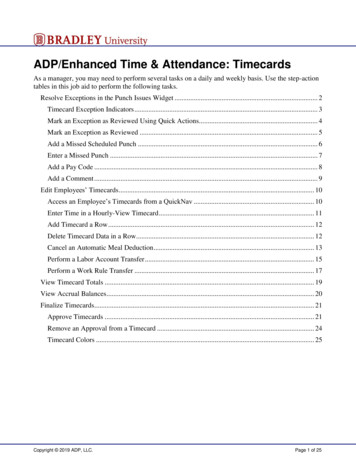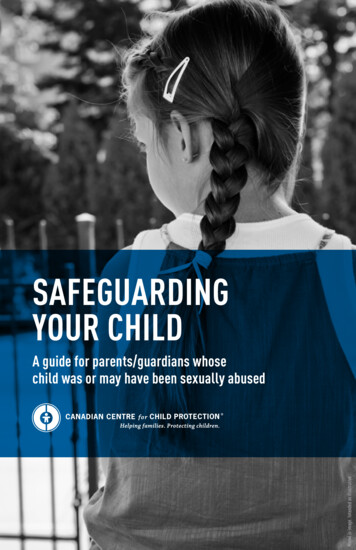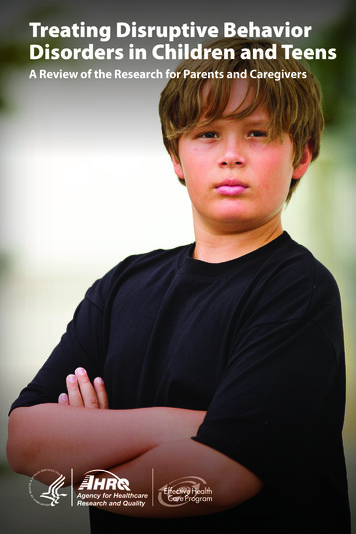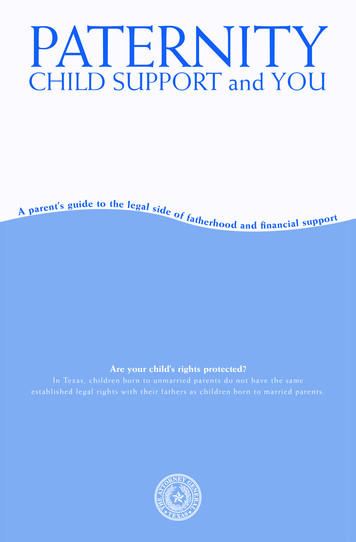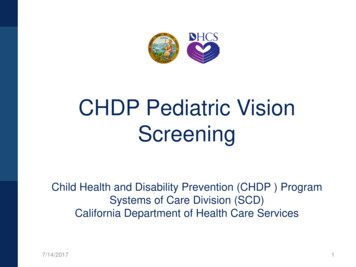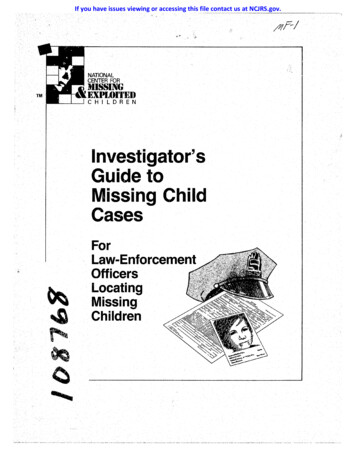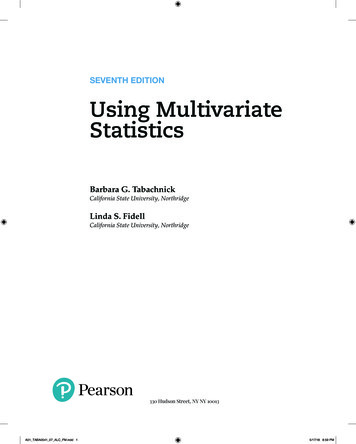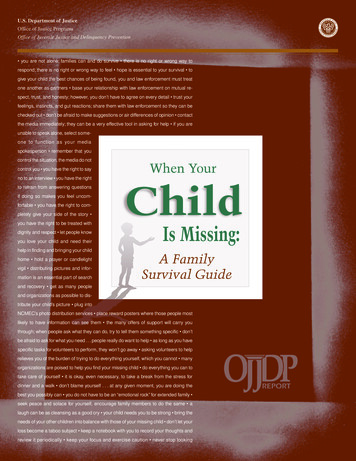
Transcription
IJJO F OJJ D P B ROJ US T I C E POffice of Juvenile Justice and Delinquency Prevention you are not alone; families can and do survive there is no right or wrong way torespond; there is no right or wrong way to feel hope is essential to your survival togive your child the best chances of being found, you and law enforcement must treatone another as partners base your relationship with law enforcement on mutual respect, trust, and honesty; however, you don’t have to agree on every detail trust yourfeelings, instincts, and gut reactions; share them with law enforcement so they can bechecked out don’t be afraid to make suggestions or air differences of opinion contactthe media immediately; they can be a very effective tool in asking for help if you areunable to speak alone, select someone to function as your mediaspokesperson remember that youcontrol the situation, the media do notcontrol you you have the right to sayWhen Yourno to an interview you have the rightto refrain from answering questionsif doing so makes you feel uncomfortable you have the right to completely give your side of the story you have the right to be treated withdignity and respect let people knowyou love your child and need theirChildIs Missing:help in finding and bringing your childhome hold a prayer or candlelightvigil distributing pictures and information is an essential part of searchSG OVCRAMSDEPANBJ A C EIOF FOffice of Justice ProgramsNT OF JMEUSRTCETIU.S. Department of JusticeA FamilySurvival Guideand recovery get as many peopleand organizations as possible to distribute your child’s picture plug intoNCMEC’s photo distribution services place reward posters where those people mostlikely to have information can see them the many offers of support will carry youthrough; when people ask what they can do, try to tell them something specific don’tbe afraid to ask for what you need . . . people really do want to help as long as you havespecific tasks for volunteers to perform, they won’t go away asking volunteers to helprelieves you of the burden of trying to do everything yourself, which you cannot manyorganizations are poised to help you find your missing child do everything you can totake care of yourself it is okay, even necessary, to take a break from the stress fordinner and a walk don’t blame yourself . . . at any given moment, you are doing thebest you possibly can you do not have to be an “emotional rock” for extended family seek peace and solace for yourself, encourage family members to do the same alaugh can be as cleansing as a good cry your child needs you to be strong bring theneeds of your other children into balance with those of your missing child don’t let yourloss become a taboo subject keep a notebook with you to record your thoughts andreview it periodically keep your focus and exercise caution never stop looking
Contact OrganizationsNational Center for Missing andExploited Children699 Prince StreetAlexandria, VA 22314800–THE–LOST (800–843–5678) (Hotline for theUnited States, Canada, and Mexico), 800–826–7653(TTD), or 703–235–3900303–235–4067 (Fax)E-Mail: 77431.177@compuserve.comInternet: www.missingkids.comCyberTipline: www.missingkids.com/cybertipFederal Bureau of InvestigationSee the front of your local telephone book for thenumber of your local FBI Field Office.Child Abduction and Serial MurderInvestigative Resources CenterNational Center for the Analysis of Violent CrimeFederal Bureau of InvestigationQuantico, VA 22135703–632–4400703–632–4350 (Fax)Branch OfficesFBI HeadquartersCalifornia: 714–508–0150Florida: 561–848–1900Kansas City (KS/MO): 816–756–5422New York: 716–254–2326South Carolina: 803–254–2326Special Investigations and Initiatives UnitCrimes Against Children Unit935 Pennsylvania Avenue NW.Washington, DC 20535–0001202–324–3666202–324–2731 (Fax)Child Protection DivisionU.S. Department of JusticeOffice of Juvenile Justice and Delinquency Prevention810 Seventh Street NW.Washington, DC 20531202–616–3637202–307–2819 (Fax)Internet: www.ojjdp.ncjrs.orgOffice for Victims of CrimeU.S. Department of Justice810 Seventh Street NW.Washington, DC 20531202–307–5983202–514–6383 (Fax)Internet: www.ojp.usdoj.gov/ovc/Association of Missing and ExploitedChildren’s Organizations, Inc.616 Adams AvenueMemphis, TN 38105901–405–8441901–405–8856 (Fax)Internet: www.amecoinc.org
When YourChildIs Missing:A FamilySurvival GuideJ. Robert Flores, AdministratorOffice of Juvenile Justice and Delinquency PreventionSecond EditionOctober 2002
U.S. Department of JusticeOffice of Justice ProgramsOffice of Juvenile Justice and Delinquency Prevention810 Seventh Street NW.Washington, DC 20531John AshcroftAttorney GeneralDeborah J. DanielsAssistant Attorney GeneralJ. Robert FloresAdministratorThis document was prepared by Fox Valley Technical College under cooperative agreement number95–MC–CX–K002 from the Office of Juvenile Justice and Delinquency Prevention, U.S. Departmentof Justice. This edition is updated from the original printing.The Office of Juvenile Justice and Delinquency Prevention is a component of the Office of JusticePrograms, which also includes the Bureau of Justice Assistance, the Bureau of Justice Statistics, theNational Institute of Justice, and the Office for Victims of Crime.
I remember standing in the middleof the chaos thinking, I wish I had abook to tell me what to do.—Colleen Nick
ForewordIn an instant, a peaceful day can become a nightmare when a child is discovered missing. Recently, we have witnessed tragic abductions of children of all ages acrossAmerica—in rural byways and major cities. We have also been heartened by the joyfulreunions of children safely returned to their parents.Children may be missing from home for a variety of reasons. They may run away aftera heated argument with their parents or be lured away by an online predator in anInternet chatroom. They may be taken by a noncustodial parent to another country—perhaps to strike back at an ex-spouse—or abducted by someone the child does not know.Whatever the reason a child is missing, parents’ lives are turned upside down, andminutes race into hours as they frantically seek their child’s return to the safety ofhome. We know that time is of the essence in terms of finding a child. What shouldparents do if their child is missing? To whom can they turn? What help can theyexpect?When Your Child Is Missing: A Family Survival Guide was written as a labor of love and avision of hope by parents who have experienced firsthand the trauma of a missing child.It has been updated to provide parents the most current information available andprovides helpful insights into what families should do—and what they can expect—when a child is missing. Above all, it offers encouragement and support at a time whenthey are needed most.I pray that you will never experience the trauma of a missing child and that every childwill be kept safe from harm and danger. Should your child become missing, however,I hope that this Guide gives you the knowledge to face this terrible challenge withstrength and determination.J. Robert FloresAdministratorOffice of Juvenile Justice and Delinquency Preventionvii
AcknowledgmentsThe Office of Juvenile Justice and Delinquency Prevention (OJJDP) is grateful to all of the peoplewho gave their time, energy, and talent to developing this Guide, especially the following parentswho know firsthand the pain, suffering, and hope of families with missing children:Heather Cox and Marion Boburka, mother and grandmother, respectively, ofShelby Cox, who was found murdered on November 18, 1995.Colleen Nick, mother of Morgan Nick, who has been missing since June 9, 1995.Claudine and Don Ryce, parents of Jimmy Ryce, who was found murdered onDecember 9, 1995.Patrick Sessions, father of Tiffany Sessions, who has been missing sinceFebruary 9, 1989.Patty Wetterling, mother of Jacob Wetterling, who has been missing sinceOctober 22, 1989.This group of parents created this Guide as a labor of love and as a message of hope and encouragement for families whose children are still missing. Their courage and strength are greatly admired.OJJDP also thanks the many professionals who have given their time and effort to find children whoare missing, who have worked to prevent children from being abducted, and who have put together this Guide for families facing this crisis. This includes Helen Connelly, James P. Finley,and Joellen Talbot of Fox Valley Technical College. The final editing and production of this Guidewere performed by the Juvenile Justice Clearinghouse. OJJDP acknowledges Tina Kramer,Denise Collins, and Lauren Staples for graphic design and layout and Ellen Grogan, Irene Cooperman,and Beverly Sullivan for editorial support. OJJDP also acknowledges and thanks the many individuals who painstakingly reviewed the Guide to make sure that it provides parents with the informationthey so desperately need during these crises. Special thanks also go to Ron Laney, Director of OJJDP’sChild Protection Division. His concern for and commitment to missing children and their parents inspired the creation of this Guide.This Guide is dedicated to all the children who are separated from their families. Our prayer is thatyou always know that the search will continue until you are found.ix
Table of ContentsA Message From Assistant Attorney General Deborah J. Daniels . vForeword . viiAcknowledgments . ixIntroduction . 1Checklist: What You Should Do When Your Child Is First Missing . 2The AMBER Plan . 4Chapter 1: The Search . 5Your Role in the Search: The First 48 Hours . 5The Role of Law Enforcement in the Search . 5The Role of Volunteers in the Search . 7After the First 48 Hours: The Long-Term Search . 8The Role of Private Detectives and Psychics in the Long-Term Search . 10Key Points . 11Checklist: Gathering Evidence in the First 48 Hours . 13Chapter 2: Law Enforcement . 17Your Partnership With Law Enforcement . 17Key Points . 20Checklist: Working With Law Enforcement . 21Chapter 3: The Media . 25Media Involvement: The First 48 Hours .Media Involvement: After the First 48 Hours .Key Points .Checklist: Conducting Interviews With the Media .25283233Chapter 4: Photo and Flier Distribution . 37Photo and Flier Distribution: The First 48 Hours .Photo and Flier Distribution: After the First 48 Hours .Key Points .Checklist: Distributing Fliers .37414445xi
Chapter 5: Volunteers . 47Making the Best Use of Volunteers .Using Untrained Volunteers in the Search Effort .Using Trained Volunteers in the Search Effort .Key Points .Checklist: Working With Volunteer Searchers .4749495152Chapter 6: Rewards and Donations . 55Monetary Rewards .Monetary Donations .Key Points .Checklist: Selecting a Tipline for Leads .55565859Chapter 7: Personal and Family Considerations . 61Regaining Your Emotional and Physical Strength .Mentally Preparing for the Long Term .Helping Your Children To Regain Their Physical and Emotional Strength .Helping Extended Family Members To Regain Their Physical andEmotional Strength .Key Points .Checklist: Figuring Out How To Pay Your Bills .616464666870Recommended Readings . 73Additional Resources . 77About the Parent Authors . 87Index . 91xii
The SearchIntroductionWhen your child is missing, your whole worldseems to fall apart. You are bombarded byquestions from friends, neighbors, the police,and the media and forced to make decisionsthat you never thought you would have tomake. You feel desperate, confused, isolated.You may feel that you have nowhere to go forhelp or support.Many parents who have faced similar criseshave said that they wished they had a book totell them where to turn when their child wasmissing. They felt that they were left on theirown to figure out what to do. They longed forsomeone to give them direction or to tellthem where to go for help and what needs tobe done. They also wished they had knownwhat to expect and how to respond.This Guide was written by parents and familymembers who have experienced the disappearance of a child. It contains their combinedadvice concerning what you can expect whenyour child is missing, what you can do, andwhere you can go for help. It explains the rolethat various agencies and organizations playin the search for your missing child and discusses some of the important issues that youand your family need to consider. The firstchecklist, What You Should Do When YourChild Is First Missing, summarizes the mostcritical steps that parents should take whentheir child is first missing, including whomto call, what to do to preserve evidence, andwhere to turn for help.The rest of the Guide is divided into sevenchapters, each of which is structured to allowyou to find the information you need quicklyand easily. Each chapter explains both theshort- and long-term issues and contains achecklist and chapter summary for later reference. Chapter 1, The Search, focuses on thesearch for your child and explains how you asa parent can best participate in the search.Chapter 2, Law Enforcement, describes yourrelationship with law enforcement and offerstips that will help you work together effectively. Chapter 3, The Media, examines issuesrelated to the media, including media packages, press conferences, and interviews.Chapter 4, Photo and Flier Distribution, offerssuggestions for producing fliers about yourchild and for managing the photo and flierdistribution process. Chapter 5, Volunteers,focuses on the many uses of volunteers—both trained and untrained—to help in thesearch and to provide for the needs of thefamily. Chapter 6, Rewards and Donations,discusses the use of rewards and the management of monetary donations. Chapter 7,Personal and Family Considerations, emphasizes the need to take care of yourself, yourchildren, and members of your extendedfamily. A list of recommended readings anda list of public and private resources appearat the back of the Guide.It is important to note that there is no right orwrong way to respond to the disappearanceof a child, nor is there a right or wrong way tofeel. The path you follow must be right foryou. What makes sense for you will be basedon your needs, your experiences, and yourcircumstances. Our hope is that the Guide willhelp you to make informed decisions aboutwhat you do and how you go about it.You may find that the information in thisGuide is overwhelming right now. If so,ask family members, friends, or other support persons to read it for you. They canhelp you take the steps needed to helprecover your missing child.Finally, as hard as it may seem, try to remainhopeful. Remember that hope is more than awish, helping you to clear this hurdle. Hope isessential to your survival.1
Family Survival GuideChecklist: What You Should DoWhen Your Child Is First MissingThe first 48 hours following the disappearance of a child are the most critical in terms of findingand returning that child safely home—but they also can be the most troublesome and chaotic. Usethis checklist during those first hours to help you do everything you can to increase the chances ofrecovering your child—but if more than 48 hours have passed since your child disappeared, youshould still try to tend to these items as quickly as possible. All of the action steps described hereare covered in greater detail later in the Guide to help you gain a better understanding of what youshould be doing and why.The First 24 HoursImmediately report your child as missing to your local law enforcement agency. Ask investigatorsto enter your child into the National Crime Information Center (NCIC) Missing Persons File. There isno waiting period for entry into NCIC for children under age 18.Request that law enforcement put out a Be On the Look Out (BOLO) bulletin. Ask them aboutinvolving the Federal Bureau of Investigation (FBI) in the search for your child.Ask your law enforcement agency if it uses the AMBER Plan (America’s Missing: BroadcastEmergency Response). The AMBER Plan is a voluntary partnership between law enforcementagencies and broadcasters to activate an urgent bulletin in the most serious child abduction cases(see page 4 for more information on the AMBER Plan).Limit access to your home until law enforcement arrives and has collected possible evidence. Donot touch or remove anything from your child’s room or from your home. Remember that clothing,sheets, personal items, computers, and even trash may hold clues to the whereabouts of yourchild. The checklist in chapter 1 (Gathering Evidence in the First 48 Hours) contains detailed information about securing your child’s room and preserving evidence.Ask for the name and telephone number of the law enforcement investigator assigned to yourcase, and keep this information in a safe and convenient place.Give law enforcement investigators all the facts and circumstances related to the disappearance ofyour child, including what efforts have already been made to search for your child.Write a detailed description of the clothing worn by your child and the personal items he or shehad at the time of the disappearance. Include in your description any personal identification marks,such as birthmarks, scars, tattoos, or mannerisms, that may help in finding your child. If possible,find a picture of your child that shows these identification marks and give it to law enforcement.See the chapter 1 checklist (Gathering Evidence in the First 48 Hours) for more details.Make a list of friends, acquaintances, and anyone else who might have information or clues aboutyour child’s whereabouts. Include telephone numbers and addresses, if possible. Tell your lawenforcement investigator about anyone who moved in or out of the neighborhood within the pastyear, anyone whose interest in or involvement with the family changed in recent months, andanyone who appeared to be overly interested in your child.Find recent photographs of your child in both black and white and color. Make copies of thesepictures for your law enforcement agency, the media, your State missing children’s clearinghouse,the National Center for Missing and Exploited Children (NCMEC), and other nonprofit organizations.Chapter 4 (Photo and Flier Distribution) contains suggestions on how to produce and distributefliers and posters.Call NCMEC at 800–THE–LOST (800–843–5678) to ask for help. Also, ask for the telephonenumbers of other nonprofit organizations that might be able to help.Look in the Additional Resources section at the end of this Guide to find the telephone numberof your State missing children’s clearinghouse. Then, call your clearinghouse to find out whatresources and services it can provide in the search for your child.2
IntroductionAsk your law enforcement agency to organize a search for your child. Ask them about using tracking or trailing dogs (preferably bloodhounds) in the search effort. Read chapters 1 (The Search) and5 (Volunteers) as you prepare for the search.Ask your law enforcement agency for help in contacting the media. Chapter 3 (The Media) contains advice on working with the media.Designate one person to answer your telephone. Keep a notebook or pad of paper by the telephone so this person can jot down names, telephone numbers, dates and times of calls, and otherinformation relating to each call.Keep a notebook or pad of paper with you at all times to write down your thoughts or questionsand record important information, such as names, dates, or telephone numbers.Take good care of yourself and your family, because your child needs you to be strong. As hard asit may be, force yourself to get rest, eat nourishing food, and talk to someone about your tumultuous feelings. When you can, read chapter 7 (Personal and Family Considerations).The Second 24 HoursTalk with your law enforcement investigator about the steps that are being taken to find your child.If your law enforcement investigator does not have a copy of Missing and Abducted Children: ALaw Enforcement Guide to Case Investigation and Program Management, suggest that he or shecall NCMEC at 800–THE–LOST (800–843–5678) to obtain one. Also, your law enforcement investigator can contact the Crimes Against Children Coordinator in the local FBI Field Office to obtain acopy of the FBI’s Child Abduction Response Plan.Expand your list of friends, acquaintances, extended family members, yard workers, delivery persons, and anyone who may have seen your child during or following the abduction.Look at personal calendars, community events calendars, and newspapers to see if there are anyclues as to who was in the vicinity and might be the abductor or a possible witness. Give thisinformation to law enforcement.Expect that you will be asked to take a polygraph test, which is standard procedure. If you havenot done so yet, read chapter 1 (The Search).Ask your law enforcement agency to request that NCMEC issue a broadcast fax to law enforcement agencies around the country. If you have not already read chapter 4 (Photo and Flier Distribution), try to read it now.Work with your law enforcement agency to schedule press releases and media events. If necessary, ask someone close to you to serve as your media spokesperson. Chapter 3 (The Media)provides tips on working with the media.Talk to your law enforcement agency about the use of a reward. When you can, read chapter 6(Rewards and Donations).Report all extortion attempts to law enforcement.Have a second telephone line installed with call forwarding. Get caller ID and call waiting. Ask lawenforcement to install a trap-and-trace feature on your phone. Get a cellular phone or pager so youcan be reached when you are away from home.Take care of yourself. Don’t be afraid to ask others to take care of your physical and emotionalneeds and those of your family. Read chapter 7 (Personal and Family Considerations) for specificsuggestions.Make a list of things that volunteers can do for you and your family. See chapter 5 (Volunteers)for ideas.Call your child’s doctor and dentist and ask for copies of medical records and x rays. Give them tolaw enforcement.3
Family Survival GuideThe AMBER PlanWhat Is the AMBER Plan?The AMBER Plan is a voluntary partnership between law enforcement agencies andbroadcasters to activate an urgent news bulletin in the most serious child abduction cases.Broadcasters use the Emergency Alert System (EAS), formerly called the EmergencyBroadcast System, to air a description of the missing child and suspected abductor.How Does the AMBER Plan Work?Once law enforcement is notified about an abducted child, they first determine if the casemeets the AMBER Plan’s criteria for triggering an alert. NCMEC suggests that the followingthree criteria be met before an alert is activated: Law enforcement confirms the child abduction. Law enforcement believes the child is in danger of serious bodily harm or death. Sufficient descriptive information exists to believe that an immediate broadcastwill help.If these three criteria are met, alert information is put together and faxed to radio stationsdesignated as primary stations under EAS. These stations then send the same informationto area radio, television, and cable systems where it is broadcast to millions of listeners.Radio stations interrupt programming to announce the alert and television and cablestations run a “crawl” on the screen with a picture of the missing child.For more information about the AMBER Plan, visit the NCMEC Web site atwww.missingkids.com.I f we could have gotten the word outimmediately when Morgan disappeared,I’m certain she would be home with metoday. With the AMBER Plan . . . time isnow on the side of every parent and child.—Colleen Nick4
The SearchCHAPTER 1The SearchNot knowing where your child is or if he or she is okay is thehardest thing in the world to handle.—Colleen NickWhen a child is reported missing, emotionsbecome raw, which can hinder the ability ofparents to make rational decisions. Yet, theactions of parents and of law enforcement inthe first 48 hours are critical to the safe recovery of a missing child. Knowing what you cando, what others can do, and where to go forhelp will not only expedite the search andrecovery of your child, it also will help to easethe emotional and financial burden of thesearch. This chapter examines your role andthe role of others in the immediate search foryour missing child and discusses what stepsshould be taken in the event that your childdoes not return within the first few days.Your Rolein theSearch:The First48 Hoursinvestigators and to be at home in the eventyour child calls. The checklist Gathering Evidence in the First 48 Hours identifies the mostcrucial pieces of background information andevidence that law enforcement will need inthe search for your child.The Role of LawEnforcement inthe SearchWhen a child has disappeared, most ofthe initial searching of the area where thechild is believed to have been last will becoordinated by law enforcement—eitherFederal, State, orlocal, depending onthe circumstances ofthe disappearance.remember sittingLaw enforcementaround our kitchen table onneeds to direct thethe first night our son wassearch effort in ordertaken when the investigatorsto make sure that theasked me, “Is there anybodysearch is performedwho liked Jacob too much?properly and that theWho gave him specialevidence located duringattention or presents? Whothe search—and at thecrime scene—is propwanted to take him places?”erly protected andI never dreamed that a nicepreserved.person could have takenIIn the initial stage ofthe search, devote yourtime to providing information to and answering questions frominvestigators. Once youdiscover that your child ismissing, you will desperour son or that the mostUsually, law enforceately want to help withcommon lure is attentionment agencies canthe search. You may, inand affection.quickly obtain thefact, wonder how you—Patty Wetterlingnecessary equipmentpossibly can stand by andand mobilize addilet others look for yourtional personnel bychild. But the reality is thatbringing in outsidein mo
Survival Guide U.S. Department of Justice Office of Justice Programs Office of Juvenile Justice and Delinquency Prevention D E PA R T M E N T OF J U S T I C E O F F I C E O F JUST I C E P R O G R A M B S J N I J O J D P B J S O V C you are not alone; families can and do survive there is no right or wrong way to
